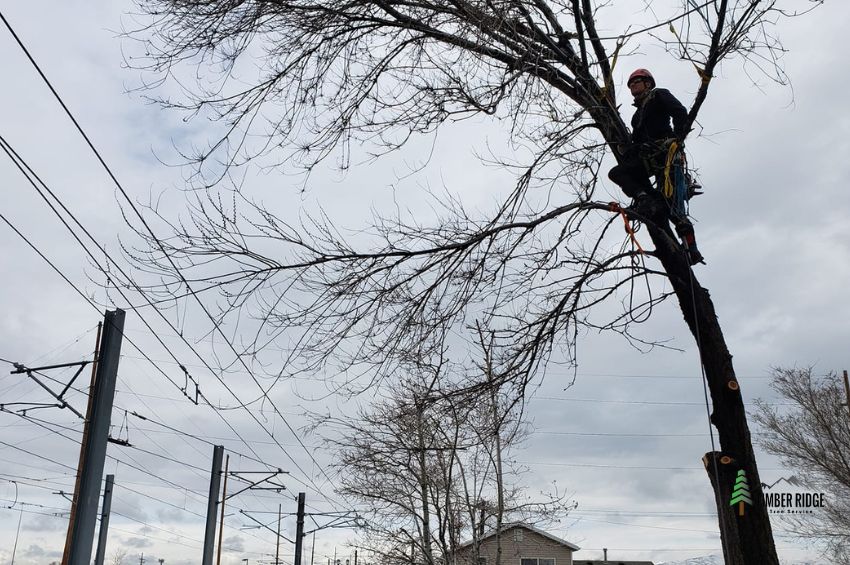
Having trees on your property provides shade, beauty, and privacy but also comes with responsibility – the duty to recognize and respond to emergency situations that may threaten their well-being or pose risks to life and property. You can’t always tell when a tree emergency is about to happen, and sometimes (such as with a lightning strike) there’s no warning. However, routine checks from the experts at Timber Ridge Tree Service can save you thousands of dollars with a quick preventative check.
Understanding what constitutes an emergency tree situation requires a keen eye attuned to the subtle signs and not-so-subtle signals that a tree may be in distress. It is a nuanced interplay between observation, knowledge, and a swift response, acknowledging that the consequences of neglecting such situations can be severe.
One of the most immediate signs of an emergency tree situation is visible damage. Whether inflicted by a storm, high winds, or other external forces, a tree with broken or hanging branches poses an imminent threat. These damaged limbs, if left unaddressed, may fall unpredictably, endangering pedestrians, vehicles, or nearby structures. Recognizing the urgency in such cases is paramount, as prompt action can mitigate potential hazards and prevent further harm.
Another red flag indicating an emergency is a sudden lean or shift in the tree's posture. While some trees naturally have a slight lean, a sudden change in this inclination could signify compromised stability. This might result from weakened roots, soil erosion, or structural damage, all of which demand immediate attention. A leaning tree, especially one in close proximity to structures or high-traffic areas, poses an elevated risk of toppling, making it a situation that requires urgent intervention.
Root issues are often hidden from plain view, but their consequences can be profound. When a tree's roots are compromised, whether due to disease, construction damage, or soil-related issues, the entire stability of the tree is at stake. Signs of distress may manifest above ground, such as sparse foliage or dieback, serving as silent indicators of an underlying emergency below the surface. Addressing root-related concerns promptly is crucial to preserving the tree's structural integrity and preventing potential disasters.
Diseases and pests, if left unchecked, can quickly escalate into emergency situations. A tree suffering from a severe infestation or disease may exhibit symptoms like wilting, discoloration, or the premature shedding of leaves. In such cases, the urgency lies in identifying the underlying cause and implementing appropriate remedies. Delayed action not only jeopardizes the health of the infected tree but also poses a risk to neighboring trees, creating a domino effect within the ecosystem.
Furthermore, the proximity of trees to power lines adds an additional layer of urgency. A tree's branches coming into contact with power lines can lead to power outages, fires, or even electrocution hazards. Recognizing the potential danger in these situations demands swift communication with utility companies and professional arborists to address the issue safely and efficiently.
Storm-damaged trees, with limbs entangled in power lines or resting precariously on structures, create emergency scenarios that require immediate resolution. The aftermath of severe weather events often leaves a trail of compromised trees, demanding a rapid response to mitigate safety risks and prevent further damage. In these situations, collaboration between homeowners, local authorities, and tree care professionals is essential to ensure a coordinated and effective response.
While the urgency of an emergency tree situation is clear in instances of visible damage or immediate hazards, a more subtle but equally critical situation is the gradual decline of a tree's health. Symptoms like persistent leaf discoloration, stunted growth, or the premature shedding of leaves may indicate underlying issues that, if ignored, can lead to irreversible damage. Recognizing the urgency in these cases requires a proactive approach, where diagnostic measures are employed to identify and address the root cause before the situation worsens.
Deciphering what constitutes an emergency tree situation is an art grounded in observation, knowledge, and a swift response. The urgency lies not only in the visible signs of distress but also in the potential hazards that may unfold if action is delayed. Trees, as stalwart guardians of our landscapes, deserve our vigilance and care. Recognizing and responding to emergency situations ensures not only their continued well-being but also the safety and harmony of the environments they inhabit. In this delicate dance between nature and human habitation, our ability to discern and address these situations promptly is a testament to our commitment to coexist harmoniously with the silent giants that grace our surroundings. Contact Timber Ridge Tree Service for all immediate tree damage needs or to schedule a tree check appointment.